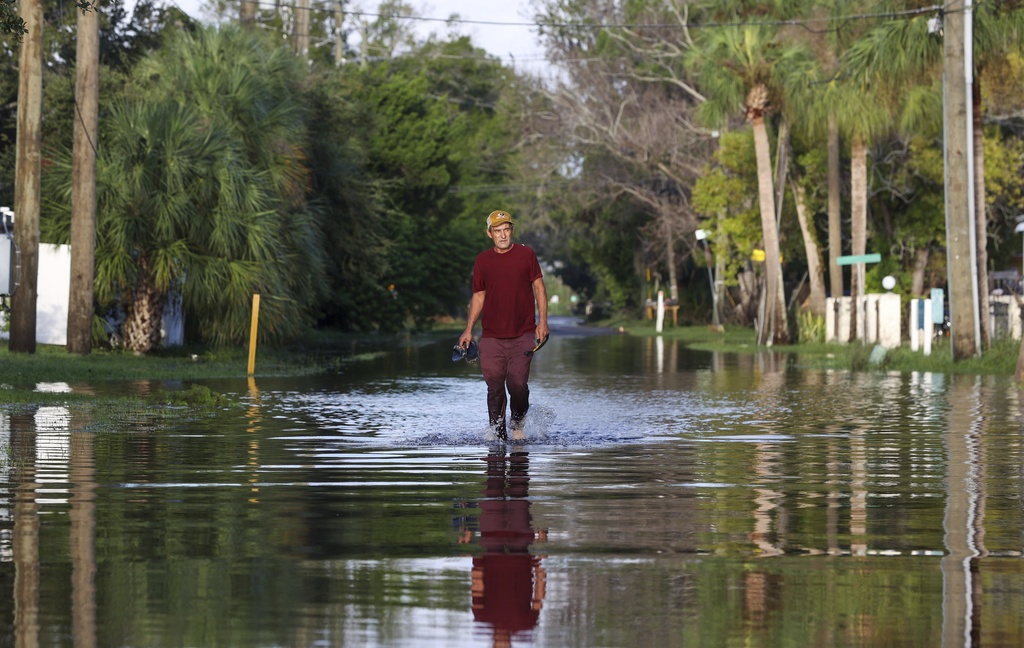Hurricane Helene’s Impact: Floods, Fatalities, and Power Outages \ Newslooks \ Washington DC \ Mary Sidiqi \ Evening Edition \ Hurricane Helene, now downgraded to a post-tropical cyclone, left massive destruction after making landfall in Florida as a Category 4 storm. With at least 40 deaths across multiple southeastern states, the storm caused severe flooding and widespread power outages. Emergency operations are in full swing, with rescue teams addressing the critical aftermath.

Hurricane Helene’s Devastation: Quick Looks
- Helene hit northwestern Florida as a Category 4, now downgraded to a post-tropical cyclone.
- Fatalities reached 40, with Georgia, South Carolina, North Carolina, and Florida all affected.
- Flooding continues to overwhelm southeastern states, with at least 1 million homes without power.
- Swift-water rescues ongoing, particularly in the Carolinas and Tennessee.
- Tennessee dam failure prompted mass evacuations, complicating rescue operations.
- Severe infrastructure damage, mudslides, and road washouts crippled transportation networks.
- Officials urge residents to exercise caution amidst ongoing rescue and recovery efforts.
Deep Look
Hurricane Helene, which made landfall as a Category 4 storm in northwestern Florida, has since weakened to a post-tropical cyclone, leaving widespread destruction in its wake. The storm, which initially reached land late Thursday night, continued north through several southeastern states, resulting in flooding, significant infrastructure damage, and power outages that have affected millions of residents.
Fatalities and Impact Across States
The storm has tragically claimed at least 40 lives across multiple states, with the death toll steadily rising. South Carolina has reported 17 fatalities, including two firefighters who were killed when a tree fell on their vehicle. In Georgia, at least 15 people have lost their lives, while four people in North Carolina were critically injured when a tornado touched down in Rocky Mount, causing considerable damage to multiple buildings. In Florida, the storm surge proved especially deadly in Pinellas County, where five residents who ignored evacuation orders died after becoming trapped in floodwaters.
The widespread impact of Hurricane Helene has left communities grappling with the fallout. The hardest-hit areas, such as Florida’s Big Bend region, Valdosta in Georgia, and parts of western North Carolina, are experiencing one of the most severe natural disasters in recent history. Taylor County, Florida, has been particularly devastated, with community members still reeling from the aftermath of three hurricanes in just over a year, compounded by the recent closure of a key local paper mill. Aaron Portwood, publisher of Perry Newspapers in Taylor County, shared the deepening sense of loss, noting that it feels like “blow after blow.”
Flooding and Infrastructure Damage
The storm’s impact extended well beyond loss of life. In Georgia, the rural community of Valdosta experienced significant damage, with at least 115 buildings heavily affected, and multiple people trapped within collapsed structures. The severe flooding also forced authorities to conduct numerous rescues across the region. Governor Brian Kemp has called upon additional National Guard units to assist with rescue operations, as several hospitals in southern Georgia have been left without power due to both primary and backup generators failing.
The neighboring states of North and South Carolina were also hit hard by the storm. In Asheville, North Carolina, authorities issued a curfew due to significant flooding and downed power lines, with more than 130 swift-water rescues conducted. Buncombe County’s emergency services have been stretched to the limit, with officials warning that recovery could take weeks, if not longer. Ryan Cole, the county’s assistant director of emergency services, emphasized the importance of community patience during these challenging times, as emergency crews work tirelessly to clear debris, repair infrastructure, and assist those affected.
Flooding continues to be a significant issue across the impacted states, with rivers cresting above record levels and dams pushed to their limits. In eastern Tennessee, the catastrophic failure of the Waterville Dam forced officials to order the evacuation of downtown Newport. The failure led to rapidly rising waters and a desperate rescue operation, with dozens being airlifted from the roof of the Unicoi County Hospital, which was inundated with floodwaters. In Rutherford County, North Carolina, the iconic Lake Lure—famous for its role in the movie “Dirty Dancing”—overtopped its dam, forcing residents downstream to evacuate. Although officials have stated that the dam is not at immediate risk of failure, erosion caused by overtopping remains a concern.
Power Outages and Strained Resources
As Helene moved across the Southeast, millions were left in the dark, with power outages affecting both rural and urban areas alike. In South Carolina, more than 1 million customers were without power, with utility companies warning that it could take days before full restoration is possible. Dominion Energy’s President Keller Kissam urged residents to remain patient, as debris-laden streets and damaged infrastructure have made repair efforts extremely challenging.
In Georgia, the damage to the state’s utility infrastructure was described as “catastrophic” by the Georgia Electric Membership Corporation, with more than 100 high-voltage transmission lines and over 60 substations rendered inoperable. The corporation noted that restoration efforts could take longer in rural areas, where residents are more dispersed, complicating repair logistics. Georgia Power CEO Kim Greene warned that outages are expected to continue rising as saturated ground and heavy winds bring down more trees.
Transportation and Evacuations
The storm also led to significant transportation disruptions. In Asheville, North Carolina, road washouts, mudslides, and flooding forced the closure of key roads, including portions of Interstate 40 and Interstate 26. The Tennessee Department of Transportation similarly reported that a section of I-40 at the North Carolina-Tennessee state line had collapsed into the swollen Pigeon River, with transportation officials scrambling to make alternative arrangements to keep essential routes open.
Evacuation orders were issued in multiple regions as dam failures and river flooding threatened communities. The Tennessee Emergency Management Agency ordered the evacuation of downtown Newport following the failure of the Waterville Dam, while residents downstream of Lake Lure in North Carolina were similarly forced to evacuate as water levels overtopped the dam. Governor Brian Kemp of Georgia warned residents near Lake Rabun of potential flooding, advising them to evacuate before rising waters cut off access to essential roads.
Community and Government Responses
Across the region, local authorities and state governments are coordinating efforts to ensure public safety and restore essential services. In Florida, Governor Ron DeSantis offered reassurances that even the hardest-hit communities would bounce back, though he acknowledged the difficulties many families face, particularly those who have lost homes and irreplaceable belongings. During a visit to storm-ravaged St. Pete Beach, DeSantis emphasized the resilience of the state’s residents, vowing that support would be provided to all those affected.
The Tennessee National Guard and other emergency personnel were deployed to assist in helicopter rescues at flooded hospitals and perform swift-water rescues in communities overwhelmed by the storm. In Georgia, Governor Kemp stated that multiple hospitals were left without power due to the storm’s impact, complicating the delivery of critical care in the midst of an ongoing emergency. Efforts to restore power to hospitals and other key infrastructure were underway, but officials stressed that it could take some time before full service is restored.
Community solidarity has been a common theme throughout the affected areas, with residents banding together to help one another. In Valdosta, Georgia, Pastor Wade McCrae from Union Cathedral expressed gratitude that his congregation’s sanctuary had remained standing despite the severe damage to the church’s steeple and windows. He noted that despite the damage, church members were ready to come together and assist in recovery efforts. Similarly, in Cedar Key, Florida, resident Michael Presley Bobbitt chose to stay behind during the storm to help neighbors in need, despite the risk. He described his town as being “gut-punched,” with rows of homes destroyed, but remained determined to support his community through the recovery.
A Long Road to Recovery
The path to recovery is expected to be long and arduous, with officials estimating that it could take weeks or even months before some areas return to a semblance of normalcy. Many regions are still grappling with the immediate impacts of the storm, including road closures, power outages, and ongoing flooding. The cleanup effort is complicated by the extensive damage to infrastructure, which has left communities isolated and reliant on emergency services for basic needs.
Federal aid and insurance payouts will play a crucial role in supporting the rebuilding effort, but authorities caution that it will take time for these resources to reach those in need. The estimated insurance payouts for damages from Hurricane Helene are expected to exceed $5 billion, significantly higher than those for Hurricane Idalia last year, due to the storm’s broader wind field and impact on urban areas.
As the remnants of Hurricane Helene continue to move northward, officials are urging residents across the southeastern U.S. to remain cautious, stay informed about the evolving situation, and heed the advice of emergency services. Although the storm has weakened, the risk of flooding, downed power lines, and other hazards remains high, particularly in areas where rivers are still cresting or where infrastructure has been compromised.
The story of Hurricane Helene is not just one of devastation but also one of resilience, as communities across the Southeast work together to rebuild, support one another, and restore a sense of normalcy in the aftermath of a powerful and destructive storm. While challenges undoubtedly lie ahead, the strength and determination of those affected by Hurricane Helene offer hope for a brighter future as they begin the long process of recovery.







